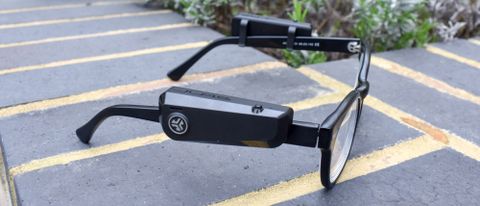Tom's Guide Verdict
The JLab JBuds Frames can add speakers and a mic to any pair of glasses, but with poor sound it’s a better concept than it is a real product.
Pros
- +
Cheaper than smart glasses
- +
Decent battery life
Cons
- -
Poor sound quality
- -
Not ideal for thick frames
Why you can trust Tom's Guide
Colors: Black
Battery life (rated): 8 hours
Connectivity: Bluetooth 5.1
Processor: Not stated
Size: 2.1 x 0.7 x 0.9 inches (per unit)
Weight: 0.4 ounces (per unit)
Smart glasses, weirdly, aren’t ideal for people who actually need to wear glasses. Not all smart glasses let you add a pair of prescription lenses, and for those that do…you need to pay for a new pair of prescription lenses. The JLab JBuds Frames tries a different approach: adding speakers and microphones to a pair of specs you already own.
It’s a set of two small-ish modules that clip on to each of your glasses’ temples, with tiny speakers at the rear that can play music or podcasts into your ears. It’s a great idea in theory, especially if you want to avoid dropping hundreds of dollars on all-new eyewear — though as our JLab JBuds Frames review will explain, actually using it will make you wish you just went with a pair of the best wireless earbuds instead.
- Want more wearables? Check out our best smartwatch picks
- We’ve tested the best headphones with a mic for voice and video calls
JLab JBuds Frames review: Price and availability
One thing that JBuds Frames has going for it is pricing. Right now it’s only available to pre-order from JLab, for delivery in late April, but it costs just $49 per pair.
Next to the Amazon Echo Frames v2 or the Bose Frames Tempo, which are both $249, that looks like a great deal even if you don’t need prescription glasses. It’s a lot cheaper than the Huawei Eyewear II, though that’s not available in the U.S.
JLab JBuds Frames review: Design
The JBuds Frames essentially take the mic and speaker portions of these fully-fledged smart glasses, put them in little Bluetooth-enabled modules and let you clip them to any pair of glasses you choose. It doesn’t need to be prescription spectacles either — you might have a favorite pair of sunglasses to which you want to add audio.
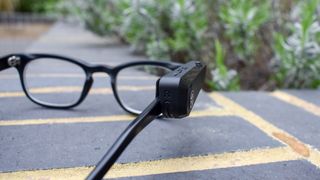
The 16mm dynamic drivers face backwards, so they’re angled towards your ears when attached, while the microphones and charging connectors sit on the undersides. Each module also includes two multifunction buttons that do different things depending on the number of times they’re pressed.

On the right button, a single press will raise playback volume, a double press will play or pause, holding the button will track forward, and triple pressing will switch between the “JLab Signature” and “Bass Boost” sound profiles. These buttons can also handle call controls, or summon your phone’s voice assistant. Siri, Alexa and Google Assistant are all supported, though I sometimes had to repeat my queries to Google Assistant.
JLab JBuds Frames review: Comfort and fit
To help attach to different temple thicknesses, the clips can be fitted with rubbery little sleeves. These are reversible but thicker on one side, so you can swap them around according to how chunky your frames are.
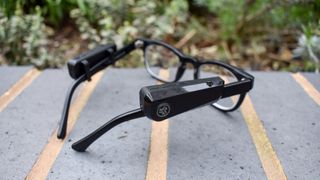
It’s a nice touch, though trying to securely for the JBuds Frames to my thicker-than-most glasses revealed the first set of problems. Firstly, my glasses were too thick for the sleeves to be necessary, but because the Frames’ clips are smooth, I couldn’t get anywhere near a reassuring level of grip. In the end the modules mostly stayed put, but were prone to sliding around when I used the control buttons, and on one occasion, removing my glasses caused the right module to simply fall off.
Secondly, although the modules generally feel well-built, I don’t trust the structural integrity of those tiny plastic clips. Judging by how they poke outwards when grabbing my glasses, I’d get paranoid of them weakening over time and eventually snapping.
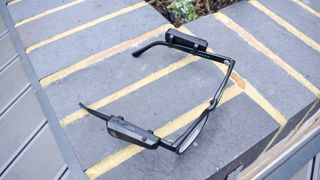
Again, my specs are thicker than average, so if you have a very thin pair of metal frames you might not have my issues. But then it’s not like I had mine made to be as bulky as possible — they’re an off-the-shelf design, with temples of comparable thickness to probably millions of other pairs.
There’s also the issue of aesthetics. Amazon and Bose’s smart glasses might not be gorgeously svelte but they do a much better job of disguising their audio hardware than the JBuds Frames’ modules, which stick out both figuratively and literally. Together they also add close to an ounce of weight to your glasses; I found myself needing to push mine back up to the bridge of my nose more than I normally would.
JLab JBuds Frames review: Sound quality
It’d be easier to look past some of the JBuds Frames’ design missteps if the audio quality wasn’t so bad. Even with each unit pushed right back against my ears, music sounded tinny at best and grating at worst.
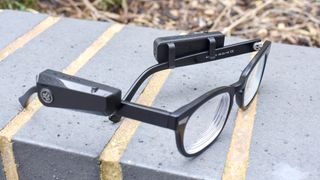
There’s no real low-end to speak of, even with the Bass Boost sound profile active. As a result, dance and electronic tracks are robbed of their power: Emily Nash’s “Pressure” trundled along with flat synths and weak drums.
Rock music, or really anything with distortion effects, comes off even worse. What should have been crushing guitars in Architects’ “Little Wonder” were instead recessed and scratchy, with minimal separation between individual instruments.

The one good thing about the JBuds Frames’s sound is that certain upper-mid and treble tones do come through clearly, so it can make a passable attempt at genres like jazz and classical — the piano in Benjamin Grosvenor’s version of the George Gershwin classic “Rhapsody in Blue” even had a cute little twinkle to it. Still, you shouldn’t expect much of a sense of scale from full orchestra recordings, even with the volume cranked up. The open design helps the soundstage stretch out a little, but the higher frequencies are never filled out by deeper mids and bass.
JLab JBuds Frames review: Sound leakage
For some, the biggest problem may not be how the JBuds Frames sounds to the user, but to the people around them. As sound is fired vaguely towards your ears instead of directly into them, like a pair of headphones, anyone close to you can hear exactly what’s playing.

While not as intrusive on a busy street, in a quiet park and especially indoors, the potential for annoyed looks is enormous. JLab says this product might suit office workers who want to listen to something while keeping their ears open for important conversations, but unless it’s a private office this just seems like an efficient way to make all your colleagues hate your guts.

More generally, despite the JBuds Frames being made to fix a specific problem — smart glasses being unsuitable for prescription glasses wearers — it’s hard to think who it would be perfect for. Runners and cyclists, perhaps? The lack of sound isolation can be a benefit as it helps you stay alert for sounds of oncoming traffic or unseen pedestrians. Still, as the best running headphones show, a tight fit is essential for exercise and the JBuds Frames’ clips might not be secure enough to avoid coming loose.

Listening in public or communal areas is bordering on socially unacceptable, so headphones and earbuds would be better there too. And if you’re alone, either at home or at work, why not just use a Bluetooth speaker or your computer speakers for superior audio quality?
JLab JBuds Frames review: Call quality
At least the microphones work better than the speakers. When using the JBuds Frames for phone calls, I apparently sounded fine — some low-end distortion was reported, but compared to when I used my phone’s own mic, the clarity of my voice was better on the JBuds Frames.
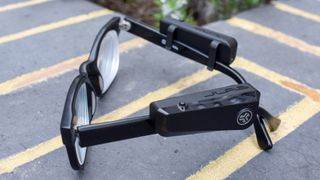
And, when I went outdoors, I was told background noise was faintly audible but not enough to drown me out.
Microphone quality is therefore a win for a product in desperate need of one, though again the speakers stop this from being a fully rounded calling headset. Even with the volume on maximum, I struggled to hear the other side of the conversation when outdoors. I can’t imagine this being an ideal way to take calls when out on a bike ride or jogging through town.
JLab JBuds Frames review: Battery life
JLab says the JBuds Frames will last 8 hours per charge, the same as the Bose Frames Tempo but less than the 14 hours of the Echo Frames v2. Personally I got dead-on 6.5 hours of continuous music playback, with the volume at 50%.

In fairness that’s more than a lot of wireless earbuds; the ubiquitous Apple AirPods, for example, only lasts 4.5 hours. But then such earbuds usually come with charging cases that can top up the batteries even when you’re on the move, and the only way to recharge the JBuds Frames is with the included USB cable.
JLab JBuds Frames review: Verdict
I wanted to like the JBuds Frames. While I’m only barely brave enough to walk around east London with plastic blocks hanging off my nerd goggles, there’s a certain appeal to products that aim to serve people who can’t — for whatever reason, not just medical — use more mainstream tech kit. To the extent you could call smart eyewear mainstream, anyway.
Even at $49, though, I can’t recommend the JBuds Frames. The poor fit and dreadful sound quality make any of the best cheap wireless earbuds a better choice for on-the-go audio, and for private listening you should sooner consider one of the best cheap Bluetooth speakers.
Yes, these alternatives preclude jumping on the wearable tech bandwagon, but when the execution of the JBuds Frames falls so far short of its promise? I’d rather walk.
James is currently Hardware Editor at Rock Paper Shotgun, but before that was Audio Editor at Tom’s Guide, where he covered headphones, speakers, soundbars and anything else that intentionally makes noise. A PC enthusiast, he also wrote computing and gaming news for TG, usually relating to how hard it is to find graphics card stock.
